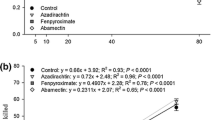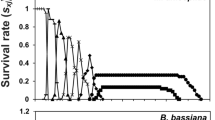Abstract
The coconut production system, in which the coconut mite Aceria guerreronis is considered a key pest, provides an interesting model for integration of biological and chemical control. In Brazil, the most promising biological control agent for the coconut mite is the phytoseiid predator Neoseiulus baraki. However, acaricides are widely used to control the coconut mite, although they frequently produce unsatisfactory results. In this study, we evaluated the simultaneous direct effect of dry residue contact and contaminated prey ingestion of the main acaricides used on coconut palms (i.e., abamectin, azadirachtin and fenpyroximate) on life-history traits of N. baraki and their offspring. These acaricides are registered, recommended and widely used against A. guerreronis in Brazil, and they were tested at their label rates. The offspring of the exposed predators was also evaluated by estimating the instantaneous rate of population increase (r i ). Abamectin compromised female performance, whereas fenpyroximate did not affect the exposed females (F0). Nonetheless, fenpyroximate strongly compromised the offspring (F1) net reproductive rate (R0), intrinsic rate of population growth (r i ), and doubling time (DT). In contrast, fenpyroximate did not have such effects on the 2nd generation (F2) of predators with acaricide-exposed grandparents. Azadirachtin did not affect the predators, suggesting that this acaricide can be used in association with biological control by this predatory species. In contrast, the use of abamectin and fenpyroximate is likely to lead to adverse consequences in the biological control of A. guerreronis using N. baraki.


Similar content being viewed by others
References
Agrofit (2015) Sistema de agrotóxicos Fitossanitários do Ministério da Agricultura, Pecuária e Abastecimento, http://extranet.agricultura.gov.br/agrofit_cons/principal_agrofit_cons. Accessed 03 January 2015
Ahmadi A (1983) Demographic toxicology as a method for studying the dicofol-twospotted spider mite (Acari: Tetranychidae) system. J Econ Entomol 76:239–242
Ansaloni T, Aucejo S, Jacas JA (2007) Estimating the intrinsic rate of increase of Tetranychus urticae: which is the minimum number of immature individuals to consider? Exp Appl Acarol 41:55–59
Aratchige NS, Sabelis MW, Lesna I (2007) Plant structural changes due to herbivory: do changes in Aceria infested coconut fruits allow predatory mites to move under the perianth? Exp Appl Acarol 43:97–107
Bostanian NJ, Akalach M (2006) The effect of indoxacarb and five other insecticides on Phytoseiulus persimilis (Acari: Phytoseiidae), Amblyseius fallacies (Acari: Phytoseiidae) and nymph of Orius insidiosus (Hemiptera: Anthocoridae). Pest Manag Sci 62:334–339
Domingos CA, Melo JWS, Gondim MGC Jr, Moraes GJ, Hanna R, Lawson-balagbo LM, Schausberger P (2010) Diet-dependent life history, feeding preference and thermal requirements of the predatory mite Neoseiulus baraki (Acari: Phytoseiidae). Exp Appl Acarol 50:201–215
Fernando LCP, Waidyarathne KP, Perera KFG, De Silva PHPR (2010) Evidence for suppressing coconut mite, Aceria guerreronis by inundative release of the predatory mite, Neoseiulus baraki. Biol Control 53:108–111
Guedes RNC, Stark JD, Smagghe G, Desneux N (2016) Pesticidal stress in arthropod pests of optimized integrated pest management programs. Annu Rev Entomol 61:43–62
Hamedi N, Fathipour Y, Saber M (2010) Sublethal effects of fenpyroximate on life table parameters of the predatory mite Phytoseius plumifer. Biocontrol 55:271–278
Haq MA, Sumangala K, Ramani N (2002) Coconut mite invasion, injury and distribution. In: Fernando LCP, Moraes GJ, Wickramananda IR (eds) Proceedings of the international workshop on coconut mite (Aceria guerreronis). Coconut Research Error! Hyperlink reference not valid.Institute, Sri Lanka, pp 41–49
Helle W, Sabelis MW (1985) Spider mites: their biology, natural enemies and control. Elsevier, Amsterdam
Hosmer DW, Lemeshow S (1999) Applied survival analysis. Wiley, New York
Ibrahim YB, Yee TS (2000) Influence of sublethal exposure to abamectin on the biological performance of Neoseiulus longispinosus (Acari: Phytoseiidae). J Econ Entomol 93:1085–1089
Lima DB, Melo JWS, Gondim MGC Jr, Moraes GJ (2012) Limitations of Neoseiulus baraki and Proctolaelaps bickleyi as control agents of Aceria guerreronis Keifer. Exp Appl Acarol 56:233–246
Lima DB, Melo JWS, Guedes RNC, Siqueira HAA, Pallini A, Gondim MGC Jr (2013a) Survival and behavioural response to acaricides of the coconut mite predator Neoseiulus baraki. Exp Appl Acarol 60:381–393
Lima DB, Monteiro VB, Guedes RNC, Siqueira HAA, Pallini A, Gondim MGC Jr (2013b) Acaricide toxicity and synergism of fenpyroximate to the coconut mite predator Neoseiulus baraki. Biocontrol 58:595–605
Lima DB, Melo JWS, Gondim MGC Jr, Guedes RNC, Oliveira JEM (2015a) Acaricide-impaired functional predation response of the phytoseiid mite Neoseiulus baraki to the coconut mite Aceria guerreronis. Ecotoxicology 24:1124–1130
Lima DB, Melo JWS, Guedes NMP, Gontijo LM, Guedes RNC, Gondim MGC Jr (2015b) Bioinsecticide-predator interactions: azadirachtin behavioral and reproductive impairment of the coconut mite predator Neoseiulus baraki. Plos One. doi:10.1371/journal.pone.0118343
Lima DB, Oliveira HKV, Melo JWS, Gondim MGC Jr, Guedes RNC, Pallini A, Oliveira JEM (2016) Acaricides impair prey location in a predatory phytoseiid mite. J Appl Entomol. doi:10.1111/jen.12327
Maia AHN, Luiz AJB, Campanhola C (2000) Statistical inference on associated fertility life table parameters using Jackknife technique: Computational aspects. J Econ Entomol 93:511–518
McMurtry JA, Croft BA (1997) Life styles of phytoseiid mites and their roles in biological control. Annu Rev Entomol 42:291–321
McMurtry JA, de Moraes GJ, Famah Sourassou N (2013) Revision of the lifestyles of phytoseiid mites (Acari: Phytoseiidae) and implications for biological control strategies. Syst Appl Acarol 18:297–320
Melo JWS, Lima DB, Pallini A, Oliveira JEM, Gondim MGC Jr (2011) Olfactory response of predatory mites to vegetative and reproductive parts of coconut palm infested by Aceria guerreronis. Exp Appl Acarol 55:191–202
Melo JWS, Domingos CA, Pallini A, Oliveira JEM, Gondim MGC Jr (2012) Removal of bunches or spikelets is not effective for the control of Aceria guerreronis. HortScience 47:1–5
Monteiro VB, Lima DB, Gondim MGC Jr, Siqueira HAA (2012) Residual bioassay to assess the toxicity of acaricides against Aceria guerreronis (Acari: Eriophyidae) under laboratory conditions. J Econ Entomol 105:1419–1425
Moore D, Howard FW (1996) Coconuts. In: Lindquist EE, Sabelis MW, Bruin J (eds) Eriophyoid mites: Their biology, natural enemies and control. Elsevier, Amsterdam, pp 561–570
Nadimi A, Kamali K, Arbabi M, Abdoli F (2009) Selectivity of three miticides to spider mite predator, Phytoseius plumifer (Acari: Phytoseiidae) under laboratory conditions. AgricSci China 8:326–331
Navia D, Gondim MGC Jr, Aratchige NS, Moraes GJ (2013) A review of the status of the coconut mite, Aceria guerreronis (Acari: Eriophyidae), a major tropical mite pest. Exp Appl Acarol 59:67–94
Negloh K, Hanna R, Schausberger P (2008) Comparative demography and diet breadth of Brazilian and African populations of the predatory mite N. baraki, a candidate for biological control of coconut mite. Biol Control 46:523–531
Negloh K, Hanna R, Schausberger P (2011) The coconut mite, Aceria guerreronis, in Benin and Tanzania: occurrence, damage and associated acarine fauna. Exp Appl Acarol 55:174–361
Ramaraju K, Natarajan K, Babu PCS, Palnisamy S, Rabindra RJ (2002) Studies on coconut eriophyid mite, Aceria guerreronis Keifer in Tamil Nadu, Índia. In: Fernando LCP, Moraes GJ, Wickramananda IR (eds) Proceedings of the international workshop on coconut mite (Aceria guerreronis). Coconut Research Institute, Sri Lanka, pp 13–31
Rezende D, Melo JWS, Oliveira JEM, Gondim MGC Jr (2016) Estimated crop loss due to coconut mite and financial analysis of controlling the pest using the acaricide abamectin. Exp Appl Acarol. doi:10.1007/s10493-016-0039-0
Sabelis MW (1985) Reproductive strategies. In: Helle W, Sabelis MV (eds) Spider mites, their biology, natural enemies and control. Elsevier, Amsterdam, pp 265–278
Saito Y (1979) Comparative studies on life histories of three species of spider mites (Acarina: Tetranychidae). Appl Entomol Zool 14:83–94
SAS Institute (2008) SAS/STAT User’s guide, version 8.02, TS level 2 MO. SAS Institute Inc. Cary, North Carolina
Silva VF, França GV, Melo JWS, Guedes RNC, Gondim MGC Jr (2016) Targeting hidden pests: acaricides against the coconut mite Aceria guerreronis. J Pest Sci. doi:10.1007/s10340-016-0776-1
Solomon MG, Cross JV, Fitzgerald JD, Campbell CAM, Jolly RL, Olszak RW, Niemczyk E, Vogt H (2010) Biocontrol of pests of apples and pears in Northern and Central Europe-3. Predators Biocontrol Sci Technol 10:91–128
Stark JD, Wennergren U (1995) Can population effects of pesticides be predicted from demographic toxicological studies? J Econ Entomol 88:1089–1096
Stark JD, Tanigoshi L, Bounfour M, Antonelli A (1997) Reproductive potential: its influence on the susceptibility of a species to pesticides. Ecotoxicol Environ Safety 37:273–279
Walthall WK, Stark JD (1997) Comparison of two population level ecotoxicological endpoints: the intrinsic (rm) and instantaneous (r i ) rates of increase. Environ Toxicol Chem 16:1068–1073
Watanabe MA, Moraes GJ, Gastaldo I Jr, Nicolella G (1994) Controle biológico do ácaro rajado com ácaros predadores fitoseídeos (Acari: Tetranychidae, Phytoseiidae) em culturas de pepino e morango. SciAgric 51:75–81
Zhang Z, Sanderson JP (1990) Relative toxicity of abamectin to the predatory mite Phytoseiulus persimilis (Acari: Phytoseiidae) and two-spotted spider mite (Acari: Tetranychidae). Annu Rev Entomol 83:1783–1793
Acknowledgments
We thank the following Brazilian agencies for their financial support: Pernambuco State Foundation for Research Aid (FACEPE), CAPES Foundation (Brazilian Ministry of Education) [PDSE/CAPES (Proc. 99999.002186/2014-04)], the National Council of Scientific and Technological Development (CNPq).
Author information
Authors and Affiliations
Corresponding author
Rights and permissions
About this article
Cite this article
Lima, D.B., Melo, J.W.S., Gondim, M.G.C. et al. Population-level effects of abamectin, azadirachtin and fenpyroximate on the predatory mite Neoseiulus baraki . Exp Appl Acarol 70, 165–177 (2016). https://doi.org/10.1007/s10493-016-0074-x
Received:
Accepted:
Published:
Issue Date:
DOI: https://doi.org/10.1007/s10493-016-0074-x




